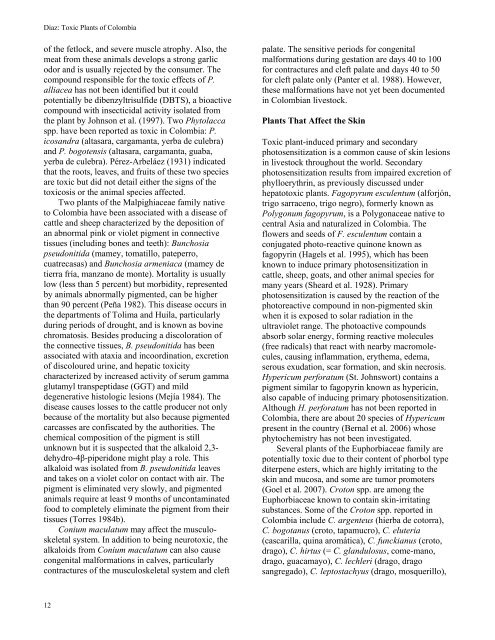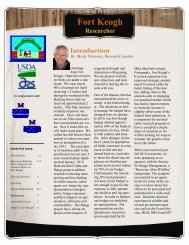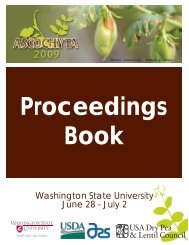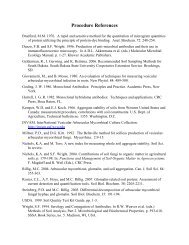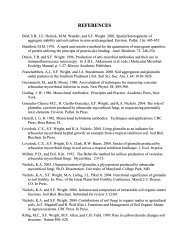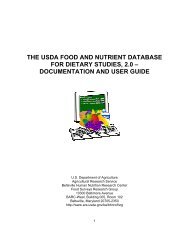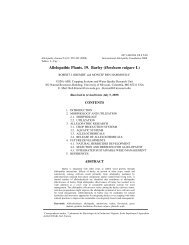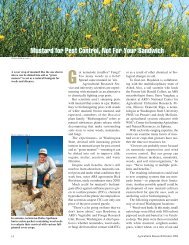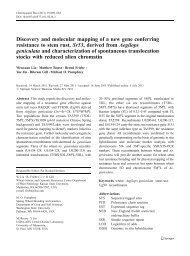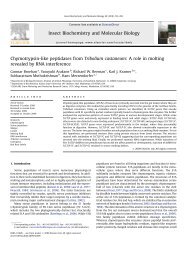International Journal of Poisonous Plant Research - Agricultural ...
International Journal of Poisonous Plant Research - Agricultural ...
International Journal of Poisonous Plant Research - Agricultural ...
Create successful ePaper yourself
Turn your PDF publications into a flip-book with our unique Google optimized e-Paper software.
Diaz: Toxic <strong>Plant</strong>s <strong>of</strong> Colombia<br />
<strong>of</strong> the fetlock, and severe muscle atrophy. Also, the<br />
meat from these animals develops a strong garlic<br />
odor and is usually rejected by the consumer. The<br />
compound responsible for the toxic effects <strong>of</strong> P.<br />
alliacea has not been identified but it could<br />
potentially be dibenzyltrisulfide (DBTS), a bioactive<br />
compound with insecticidal activity isolated from<br />
the plant by Johnson et al. (1997). Two Phytolacca<br />
spp. have been reported as toxic in Colombia: P.<br />
icosandra (altasara, cargamanta, yerba de culebra)<br />
and P. bogotensis (altasara, cargamanta, guaba,<br />
yerba de culebra). Pérez-Arbeláez (1931) indicated<br />
that the roots, leaves, and fruits <strong>of</strong> these two species<br />
are toxic but did not detail either the signs <strong>of</strong> the<br />
toxicosis or the animal species affected.<br />
Two plants <strong>of</strong> the Malpighiaceae family native<br />
to Colombia have been associated with a disease <strong>of</strong><br />
cattle and sheep characterized by the deposition <strong>of</strong><br />
an abnormal pink or violet pigment in connective<br />
tissues (including bones and teeth): Bunchosia<br />
pseudonitida (mamey, tomatillo, pateperro,<br />
cuatrecasas) and Bunchosia armeniaca (mamey de<br />
tierra fría, manzano de monte). Mortality is usually<br />
low (less than 5 percent) but morbidity, represented<br />
by animals abnormally pigmented, can be higher<br />
than 90 percent (Peña 1982). This disease occurs in<br />
the departments <strong>of</strong> Tolima and Huila, particularly<br />
during periods <strong>of</strong> drought, and is known as bovine<br />
chromatosis. Besides producing a discoloration <strong>of</strong><br />
the connective tissues, B. pseudonitida has been<br />
associated with ataxia and incoordination, excretion<br />
<strong>of</strong> discoloured urine, and hepatic toxicity<br />
characterized by increased activity <strong>of</strong> serum gamma<br />
glutamyl transpeptidase (GGT) and mild<br />
degenerative histologic lesions (Mejía 1984). The<br />
disease causes losses to the cattle producer not only<br />
because <strong>of</strong> the mortality but also because pigmented<br />
carcasses are confiscated by the authorities. The<br />
chemical composition <strong>of</strong> the pigment is still<br />
unknown but it is suspected that the alkaloid 2,3dehydro-4β-piperidone<br />
might play a role. This<br />
alkaloid was isolated from B. pseudonitida leaves<br />
and takes on a violet color on contact with air. The<br />
pigment is eliminated very slowly, and pigmented<br />
animals require at least 9 months <strong>of</strong> uncontaminated<br />
food to completely eliminate the pigment from their<br />
tissues (Torres 1984b).<br />
Conium maculatum may affect the musculoskeletal<br />
system. In addition to being neurotoxic, the<br />
alkaloids from Conium maculatum can also cause<br />
congenital malformations in calves, particularly<br />
contractures <strong>of</strong> the musculoskeletal system and cleft<br />
12<br />
palate. The sensitive periods for congenital<br />
malformations during gestation are days 40 to 100<br />
for contractures and cleft palate and days 40 to 50<br />
for cleft palate only (Panter et al. 1988). However,<br />
these malformations have not yet been documented<br />
in Colombian livestock.<br />
<strong>Plant</strong>s That Affect the Skin<br />
Toxic plant-induced primary and secondary<br />
photosensitization is a common cause <strong>of</strong> skin lesions<br />
in livestock throughout the world. Secondary<br />
photosensitization results from impaired excretion <strong>of</strong><br />
phylloerythrin, as previously discussed under<br />
hepatotoxic plants. Fagopyrum esculentum (alforjón,<br />
trigo sarraceno, trigo negro), formerly known as<br />
Polygonum fagopyrum, is a Polygonaceae native to<br />
central Asia and naturalized in Colombia. The<br />
flowers and seeds <strong>of</strong> F. esculentum contain a<br />
conjugated photo-reactive quinone known as<br />
fagopyrin (Hagels et al. 1995), which has been<br />
known to induce primary photosensitization in<br />
cattle, sheep, goats, and other animal species for<br />
many years (Sheard et al. 1928). Primary<br />
photosensitization is caused by the reaction <strong>of</strong> the<br />
photoreactive compound in non-pigmented skin<br />
when it is exposed to solar radiation in the<br />
ultraviolet range. The photoactive compounds<br />
absorb solar energy, forming reactive molecules<br />
(free radicals) that react with nearby macromolecules,<br />
causing inflammation, erythema, edema,<br />
serous exudation, scar formation, and skin necrosis.<br />
Hypericum perforatum (St. Johnswort) contains a<br />
pigment similar to fagopyrin known as hypericin,<br />
also capable <strong>of</strong> inducing primary photosensitization.<br />
Although H. perforatum has not been reported in<br />
Colombia, there are about 20 species <strong>of</strong> Hypericum<br />
present in the country (Bernal et al. 2006) whose<br />
phytochemistry has not been investigated.<br />
Several plants <strong>of</strong> the Euphorbiaceae family are<br />
potentially toxic due to their content <strong>of</strong> phorbol type<br />
diterpene esters, which are highly irritating to the<br />
skin and mucosa, and some are tumor promoters<br />
(Goel et al. 2007). Croton spp. are among the<br />
Euphorbiaceae known to contain skin-irritating<br />
substances. Some <strong>of</strong> the Croton spp. reported in<br />
Colombia include C. argenteus (hierba de cotorra),<br />
C. bogotanus (croto, tapamucro), C. eluteria<br />
(cascarilla, quina aromática), C. funckianus (croto,<br />
drago), C. hirtus (= C. glandulosus, come-mano,<br />
drago, guacamayo), C. lechleri (drago, drago<br />
sangregado), C. leptostachyus (drago, mosquerillo),


